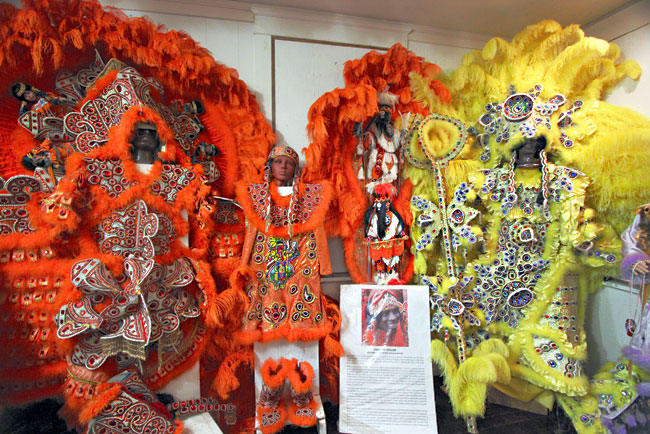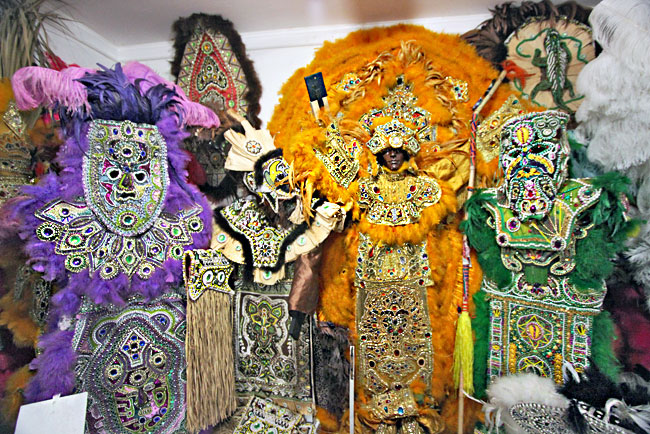Like a proud peacock, the Big Chief strutted around the courtyard, showing off his hand-beaded and sequined costume. Carefully balancing his neon-orange feathered headdress, he strode purposefully toward the Big Chief from a competing tribe. Just inches apart, they stopped in their tracks. Arms crossed over their broad chests, they glared at one another.
Chief number one looked his challenger up and down.”You pretty, but I prettier!” he said, quickly following it with the traditional demand to bow down and pay respect: “Humba!”
Chief number two closed the gap, pressing his crossed forearms against his opponent’s. “I the pretty one. Me no humba; YOU humba!”

Had this been the late 19th century, fisticuffs would likely have ensued. In those days the secret society known a the Mardi Gras Indians used the annual celebration as an excuse to settle scores. Over the past century, the violent affair has evolved into an occasion for good-natured competition between the tribes, who now meet each March during the Mardi Gras parade and festivities. The posturing between Big Chiefs makes for great entertainment but most onlookers are unaware that this interaction is rooted in New Orleans history and to a great degree, still shrouded in mystery. Luckily, I was getting the inside scoop from Tauck, which had invited me to join their annual Jazz Event in New Orleans.

Members of the Mardi Gras Indian tribes are African Americans – not Native Americans as the name would imply. They refer to themselves as Indians out of respect for Native Americans who sheltered runaway slaves, saving them from capture or even death. Once each year the Big Chief of each tribe dons a headdress with mock braids and full-length costume that he alone has sewn by hand, affixing up to a million beads, sequins, and rhinestones. Costumes can weigh more than 100 pounds, cost thousands of dollars and can take up to a year to complete, yet each costume is worn only once. The design and color of the costume is a heavily guarded secret, as is the designated parade route, which symbolizes the secret underground path followed by escaping slaves. Meanwhile, the Big Chief’s spies try to infiltrate the other tribes in the hopes of learning their intended route so they can confront their rivals on the street.

The 38 or so individual tribes that participate in the Mardi Gras are loosely confederated as either Uptown or Downtown Indians, each of which wear costumes with slightly different design features. At the Backstreet Cultural Museum we perused a collection of spectacular costumes that have been worn by Big Chiefs over the years. To my inexperienced eye, they all looked the same but the manager of the museum revealed how to tell the difference:
“Uptown Indians make flat costumes with lots of beadwork badges that tell a story and ostrich feathers that move in the wind. Downtown Indians make costumes with three-dimensional elements like bird beaks and add flat feathers into the design that don’t move.”
Seeing the Mardi Gras Indians in action usually requires being in the right place at the right time during the parade, but after visiting the museum our Tauck guide made a surprise stop in the courtyard where we were treated to a private performance by the two Chiefs. Their mock battle ended on a conciliatory note. Breaking apart, each admired the artistry of their opponent’s costume as the brass band struck up a tune.
Chief two nodded to Chief one.”Lookin’ good!”
“You too, baby; looking good!” Chief one replied as he led us into the parking lot, where we waved our white handkerchiefs in the air and danced the afternoon away.
While many tourists head to the Big Easy to take part in the Mardi Gras parade and its associated festivities, this may not be the best option for all travelers. The city is packed with tourists at this time. If like me, you don’t enjoy the crush of crowds, you can better enjoy so many more of the activities and sites in this list of things to do in New Orleans.
Disclosure: I was a guest of Tauck on their Tauck Jazz Event, one of their custom designed once-in-a-lifetime Tauck Events that provide insider insight and access for savvy travelers. However, the receipt and acceptance of complimentary items or services will never influence the content, topics, or posts in this blog. I write the truth, the whole truth, and nothing but the truth.

Great inside scoop on the Mardi Gras Indians. I love that this tradition pays tribute to the underground railroad in a most festive New Orleans beaded-sequenced-feather studded way.
If you ask around, Mary, there are second line parades going on nearly every day of the week, and you can fall in line and dance in one of them!
Wow – A guest on a Tauck Event! I hear they are amazing.
Love the rich colors and absolutely always love the native American events! The 3D pieces are incredible.
The costumes are really amazing Patty – and when you think that none are ever worn twice, even more so!
Absolutely obsessed with everything about New Orleans, until a few years ago I didn’t know much about these Indians at all. It is such a a unique tradition and just further helps to make NOLA the most unique city in America, hands down.
Hi Scott: One of our guides aid that New Orleans is the most European city in the U.S. and I have to agree.
Still kicking myself for missing this! What ever was I thinking? At least I do plan on going back!
Think of it as an excuse to go back, Anita 🙂
What wild outfits – I am struck by the unusual mix of cultural events and observations.
New Orleans has to be one of the most cultural cities in the U.S., Mark!